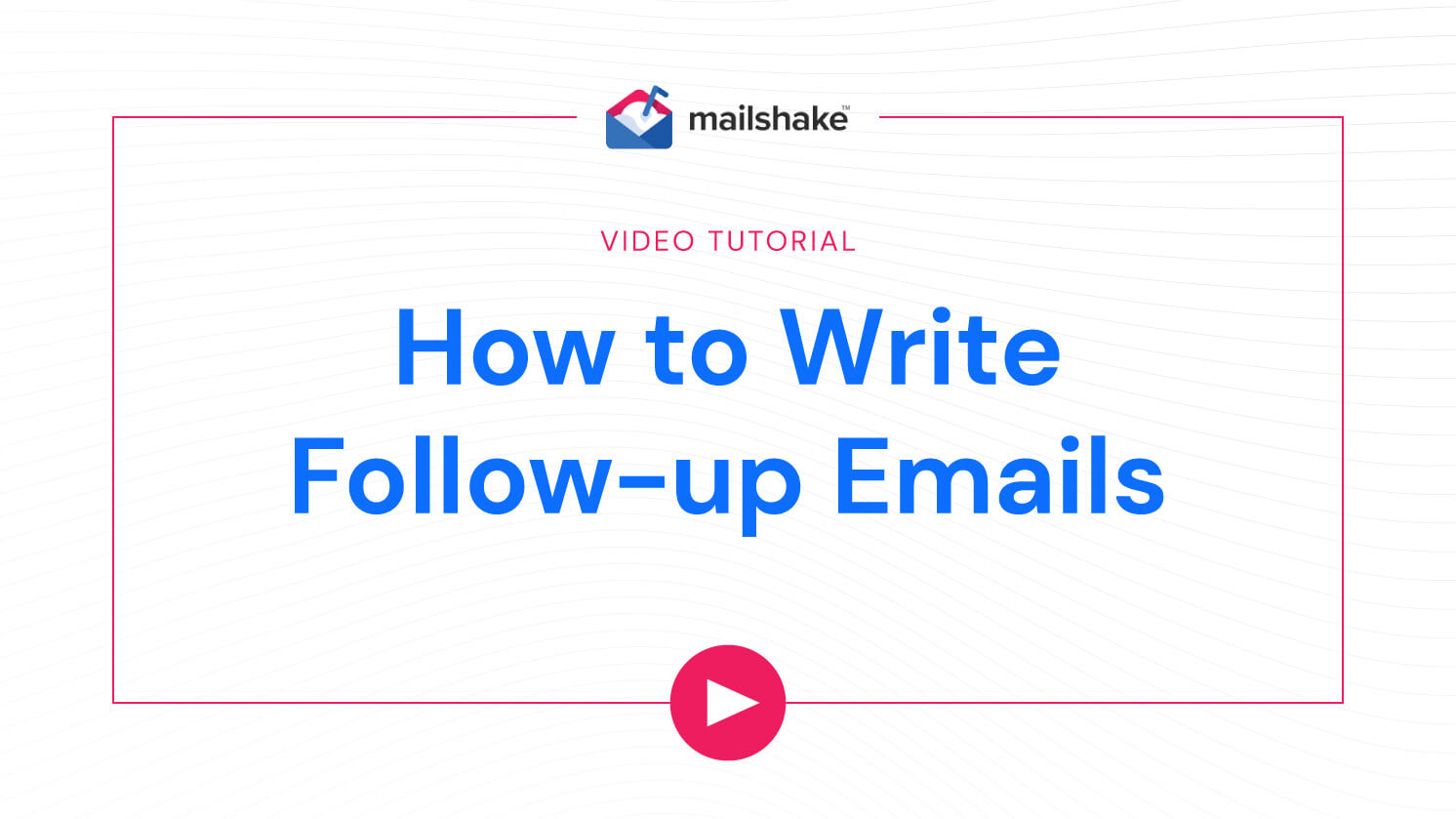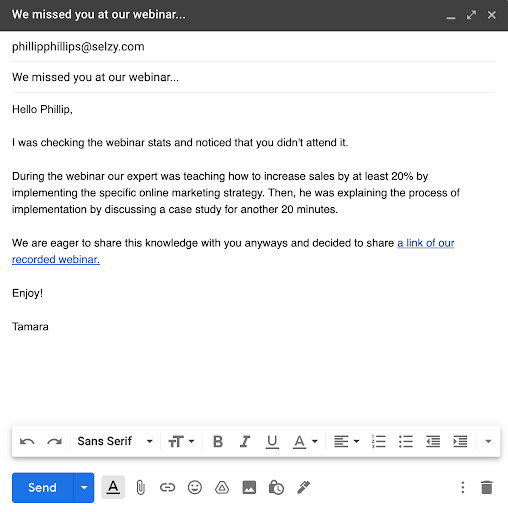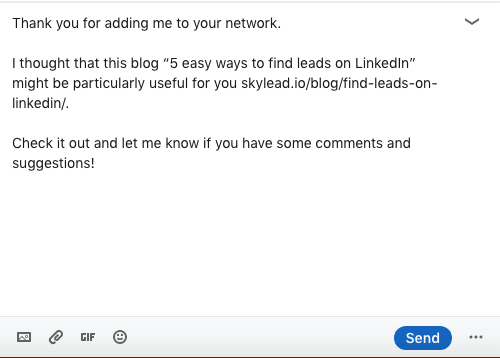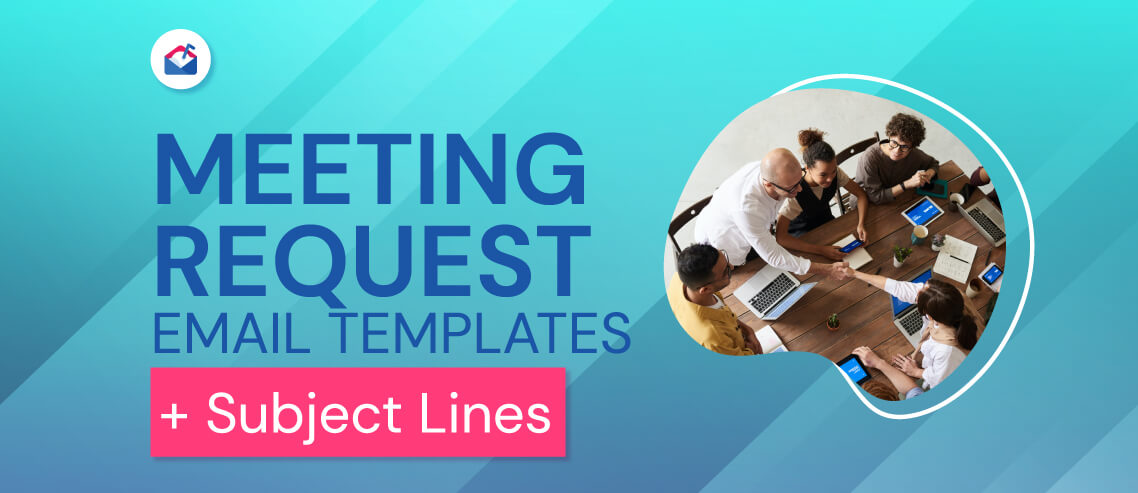14 Sales Follow-Up Email Templates to Steal for Your Next Cold Email Campaign

Contents
An all-too-common mistake when sending sales emails (or any kind of outreach email) is to overlook the follow-up sequence. Sales teams put all the emphasis on sending a great initial email, while the sales follow-up emails become little more than a box-ticking exercise.
That’s a huge oversight, since research has shown time and again that most sales result from a sales follow up email.
So why then are sales reps still:
- Sending bad emails?
- Timing their emails poorly (for instance, waiting too long to send a follow-up, not waiting long enough, or being too persistent and sending too many emails?
- Just not bothering to follow up at all?
If you’re guilty of any of these, you won’t be generating as many leads or closing as many sales as you could be—guaranteed.
While I’m not going to talk about timing today (if you’d like, you can learn more about that in our cold email masterclass), what you will get from this article is a number of sales email follow-up templates that should make touching base with potential customers easier, while also helping you send better emails throughout the sales process.

Templates for Sales Follow-Up Emails
Below are 14 templates for sales follow-up emails from my own archives and that I’ve picked up from various other websites. This means others have and may well be using them in their own follow-ups. Unless you want to risk clogging up prospects’ inboxes with duplicate emails, you should use these as inspiration—not gospel.
Before you send your first round of follow-up sales emails, take a few minutes to personalize and make your chosen template your own. Then give it a quick review before shipping it.
- Keep it Short and Sweet
- Make replying a one-stroke task for recipients
- Be brutally honest
- Acknowledge their interest
- Show absolute belief in your product’s fit for the prospect
- Follow up from a sales call
- Add value
- Walk away gracefully
1. Keep it short and sweet
All sales emails should be short, but follow ups should be even shorter. (Yes, this includes your subject lines.) However, this doesn’t mean you have to do away with all the pleasantries. You can be polite, friendly, and (most importantly) human in a quick email, while respecting their busy schedule—as this template goes to show.
Example #1: Get permission to reach out later
Hey {{Name}},
I’m reaching out because I have several ideas for how you can bring in more leads and ultimately close more deals every month. Would it be OK for me to reach out next week to share those ideas with you? Kind regards, {{Your Name}} |
Example #2: Give a quick compliment and add value
I noticed on LinkedIn that you’ve been sharing some super helpful content covering {{Industry}}.Recently I spotted these two amazing guides and just wanted to share them with you:
{{Link 1}}
{{Link 2}}
Would you be down to chat a little about our delivery rates at {{Your company}} if you’re up for it?
Cheers
{{Your Name}}
The second example here gives a relevant and innocent explanation of why you’re reaching out, while also throwing in an easy compliment. After that, it’s a quick win of sharing other content that might interest prospective clients or their followers. Instead of following up for the sake of following up this email attempts to pivot the conversation and provide value.
Finally, that sign off is a simple request that can be answered with a yes or a no. A simple formula like this works because it doesn’t take much time to skim, provides immediate value, and comes off as conversational, instead of salesy. The other benefit is that short emails work better on mobile devices.
2. Make replying a one-stroke task for recipients
You’ve probably seen something to this effect before—or I’d guess that you have, since this type of email pops up in my inbox pretty often. However, that’s not to say you shouldn’t use it yourself. This format is popular because it works. And it works because it makes it incredibly easy for prospects to reply. Just bear in mind that if you use it, you’ll need to pay extra-close attention to how much you adapt it.
Example #1: Hit me back with a number
I’m sure you get a ton of emails every day, so I don’t want to bother you if I can avoid it!
Hit me back with a number that best describes how you’re feeling:
Talk soon,
{{Your Name}}
Example #2: I’m emailing again because…
I’m emailing again because I haven’t heard back from you and I just want to gauge your interest to ensure I’m not bothering you.
Press “1” if you’re just busy but still interested…
And “2” if you’d like me to leave you alone…forever.
Cheers,
{{Your Name}}
Example #2 is refreshing because it shows complete transparency into the salesperson’s process: they use a CRM and, after so many days, circle back to gauge interest. The email subject is intriguing to encourage them to open. The sales email also sets expectations and gives recipients an easy out with the promise of not bothering them anymore—all with a simple keystroke of 1 or 0. Truly a win-win for sales professionals and email recipients.
3. Be brutally honest
Few people look forward to cold contact from a sales rep, but we accept it as part of our professional lives. This follow-up email template and email subject recognize that. And it works thanks to its simple, brutal honesty. Because just because your prospect hasn’t responded to your previous messages, doesn’t mean they’re not interested, but it might.
Example #1: Am I bugging you yet?
Salespeople are the worst…so I get it if you’d like me to stop bugging you.
That said, l’d hate to think that you missed a valuable piece of content because I didn’t send just one more email.
{{Content link}}
Let me know what you think!
Best,
{{Your Name}}
4. Acknowledge their interest
Prospects know you’re tracking your emails. You know that they know you’re tracking your emails. So why pretend that you’re not? Templates that acknowledge their interest (whether it’s a marketing campaign they viewed or an email they engaged with) can work because they compel prospects to own up to the fact that they’ve shown interest.
Example #1: I see you opened my email
I saw that you were able to check out the email I sent last week and was wondering if you had any questions.
Would you be interested in a follow-up today to discuss how {{Your business name}} could help {{Prospect company}} with {{Industry pain point}}?
Let’s chat at {{Provide two options}} tomorrow!
Talk soon,
{{Your Name}}
Example #2: I see you’re interested in X, would you like to chat about it?
I saw that your team was checking out our {{Product}} page and was wondering if they were able to get all the info they needed…
Do you have a few minutes to I can show you how it works? Seeing how {{Product}} works in real time can be really helpful.
Kind regards,
{{Your Name}}
The second example’s content revolves around a trigger event. If you’re using software like Mailshake, you can track things like email opens and clicks to links provided in the email. Since they clicked something, you know they were at least somewhat interested, so this sales follow-up email is perfect for starting that conversation.
It’s a versatile template, because it could be adapted to downloading white papers or opt-in campaigns before the clear and concise call-to-action brings it home.
MIX IT UP
Native and third-party integrations give you even more power, letting you push data from your CRM and other tools into Mailshake and vice versa.
5. Show absolute belief in your product’s fit for the prospect
Example #1: Putting your business at risk
That’s understandable!
But hey, I wouldn’t be following up if I didn’t feel like {{Your company}} can help {{Prospect company}} solve {{Industry pain point}} by {{Product benefits}}.
Let’s jump on a call and I’ll show you exactly what we can do!
Best,
{{Your Name}}
I’ve modified this email template (and email subject) slightly from the original source to work as a sales follow up email after you’ve been rejected. Now, it demonstrates your absolute confidence in your product or service, while simultaneously reinforcing how recipients will benefit.
6. Follow up from a sales call
Following up from a sales call is a must. You don’t have to be formal. Showing gratitude and giving a little extra detail can be enough. The email below does exactly that. The template expresses appreciation for the meeting, then jumps right into delivering on a promise to share extra resources. It comes off as purely transactional and far from salesy—even though it’s still essentially a sales message.
Example #1: Here’s all the goodies from our call
Amazing chat this afternoon!
Wanted to give you a quick summary of what we discussed:
Let me know if you have any other questions!
Have a great day,
{{Your Name}}
Example #2: I learned so much from our meeting
It was amazing chatting with you earlier. Your role at {{company}} seems incredibly interesting!
I can definitely see how difficult it can be to tackle {{Pain point}} in your position.
As we talked about, I’ve attached a couple of fantastic guides that may help you address some of these issues.
If you’d like to know a bit more about how we can help you implement some of these ideas in order to take care of {{Pain point}}, let me know!
Best,
{{Your Name}}
Example #2 starts strong with polite introduction that shows gratitude. From there, it gracefully acknowledges the pain points the recipient is facing, proving that you were really listening. There’s also a bonus line where you can include more reasons your solution is a perfect fit, before wrapping up with an invitation to continue the conversation. If you don’t yet have another meeting scheduled, modify this template to include a call-to-action inviting them to one.
A BLENDED APPROACH
Blend phone calls, social media outreach, and general tasks with Mailshake’s Sales Engagement plan.
7. Add value
Sharing wisdom, social proof, statistics, or any other kind of relevant content is always a great practice to deploy in sales. From your first interaction, you want to come off as a trusted advisor and a valuable resource—not just a salesperson waiting to close a deal. The email below shares a piece of content gracefully in a short and concise format. And the email subject line is just as brief.
Example #1: Sharing a quick tip
You likely deal with {{Industry pain point}}, so I thought I’d share a quick tip many of my clients have found helpful: {{1-2 sentence actionable piece of advice}}.
I have a few more ideas around {{Improving X}}. Let me know if you’re interested in hearing them.
Cheers,
{{Your Name}}
Example #2: Provide value after a meeting
You mentioned you love trying new foods. Saw this group organizing food tours around New York. Here’s one where they take you to a few ethnic restaurants: Original Multicultural Bar Hopping Tour
ounds like your taste buds will be pleased!
How’s the project coming along btw?
Cheers,
{{Your Name}}
Email #2 continues the conversation from the meeting, while also adding a personal touch of value (customize it to any hobbies your recipient has shared with you). Doing so keeps the sales follow-up email short and ends the conversation on a casual, non-intrusive CTA. That way you increase your reply rates.
8. Walk away gracefully
Sometimes you’ve hit the end of the road with a prospect, and it doesn’t make sense to keep wasting efforts on them. Rather than just simply giving up, it’s worth throwing a “Hail Mary” email out there to see if it’s enough to wake them up. Make it clear in the email subject that you’re giving them an out if they want it.
Example #1: Is it time to part ways?
Sometimes it’s just not meant to be…I get it.
Before I close your file, I just wanted to follow up one last time to ensure that you’re absolutely positively not interested in the slightest.
If you are….drop me a line. If I don’t hear from you…I’ll close the file!
Best,
{{Your Name}}
Example #2: Perhaps the timing just isn’t right
Just giving you one last email concerning {{value proposition}}.
If I don’t hear back from you, I’ll close your file and assume the timing just wasn’t right.
Please know you’re always free to send me an email or give me a call if you decide that you’re interested in learning about how {{Your company}} can help you tackle {{Pain point}}.
Goodbye for now!
{{Your Name}}
The second example is a little softer and shows empathy that they might be too busy (or that the relationship isn’t a great fit anymore). It gives respect and reiterates that you won’t reach out anymore. A last ditch effort closes the email requesting to connect if they’re still interested or will be in the future.
There’s no rule that says the focus of a follow-up email should be the fact that you’re following up. The follow-up email template above doesn’t do that, and instead tries increase the response rate by adding value in the form of a piece of advice the rep thinks they’ll find useful. If you swap that advice for a link to a resource, you’ll achieve the same effect.
9. Sell socially
Example #1: We missed you at our webinar
This follow-up is strong because it’s clear and easy to read. It gently reminds the person they missed the webinar without blaming them. Then it explains what they missed in simple terms and gives them a link to watch the replay. This helps build trust and keeps the conversation going, which is important in social selling.

Example #2: Post-webinar thank-you

This follow-up is friendly and helpful. It thanks the reader for joining the webinar and makes them feel valued. It also gives an easy-to-click link to watch the replay in case they missed anything. On top of that, it shares the speaker slides to add extra value. In social selling, this helps keep the connection strong and shows you care about helping, not just selling.
Example #4: Guest speaker invitation

The first message offers a useful blog link and invites the person to respond. It shows you care about sharing value, not just selling. This makes people more open to talking with you later.
This second message goes deeper. It shows respect for the other person’s work, shares how it helped you, and makes a kind offer (guest speaker invite). It builds trust and creates a real chance to work together. That’s social selling at its best.
3 Follow-up Mistakes to Avoid in 2025
We see these mistakes all the time at Mailshake. Avoid them like the plague:
1. Being Pushy or Aggressive
This often happens unknowingly and makes you end up looking unprofessional, with the possibility of getting blocked from communicating in the future.
You might want to be persistent in your pursuit, but try not to overwhelm the prospect by using phrases that come off as demanding or guilt-tripping them.
Instead, space out your emails and use soft, respectful language to give prospects the space they need.
2. Sending Generic, Non-personalized Messages
Many people personalize their first emails but forget to personalize their follow-ups.
If your follow-up has been copy-pasted countless times without any modification or mail merge, it will only appear as robotic and lifeless. Don’t do that.
3. Not Offering Clear Value or CTA
If your message lacks a clear purpose, your connection is less likely to respond. Aim to ask thoughtful, relevant questions that invite meaningful engagement. This not only shows genuine interest but also opens the door to a valuable conversation.
Bonus: AI Personalization Tools for Follow-up Emails
Who has the time for manual personalization in 2025? You’re right; no one. That’s why we’ve put a list of AI personalization tools you can try out:
- Lavender. Offers faster email generation and provides personalization suggestions as well as tone analysis and engagement data.
- Lyne.ai. Writes first lines based on data from LinkedIn profiles.
- Crystal. Analyzes the personality of the recipient and tailors the message tone and style according to their digital footprint.
- Seventh Sense. Useful for teams that use Marketo or HubSpot. The follow-ups are based on collected behavioral data, and the tool provides suitable times to send follow-ups.
Start automating follow-ups with Mailshake
It’s nearly impossible to stay on top of prospect outreach if you’re trying to do it manually. Instead, use an outreach tool like Mailshake to make your email communication scalable.
With Mailshake, you can:
- Personalize email outreach with mail merge
- Win more replies and revenue with automated follow-ups
- Simplify your lead workflow by catching the prospects that turn into leads
- Integrate Mailshake with your entire tech stack
The bottom line is that following up is essential to your outreach strategy and that you should be automating it to get the best possible results.
Conclusion
Remember, the important thing is that you follow up. While it can seem logical to assume that if someone hasn’t replied to your previous email, they’re not interested, that’s not necessarily the case. Very few prospects say “yes” after your initial contact.
Don’t give up before you give your prospects all the chances necessary to get to yes. Create your own sales follow-up email templates using these 14 as starting points, and test them as you continue to refine your cold email campaigns.






